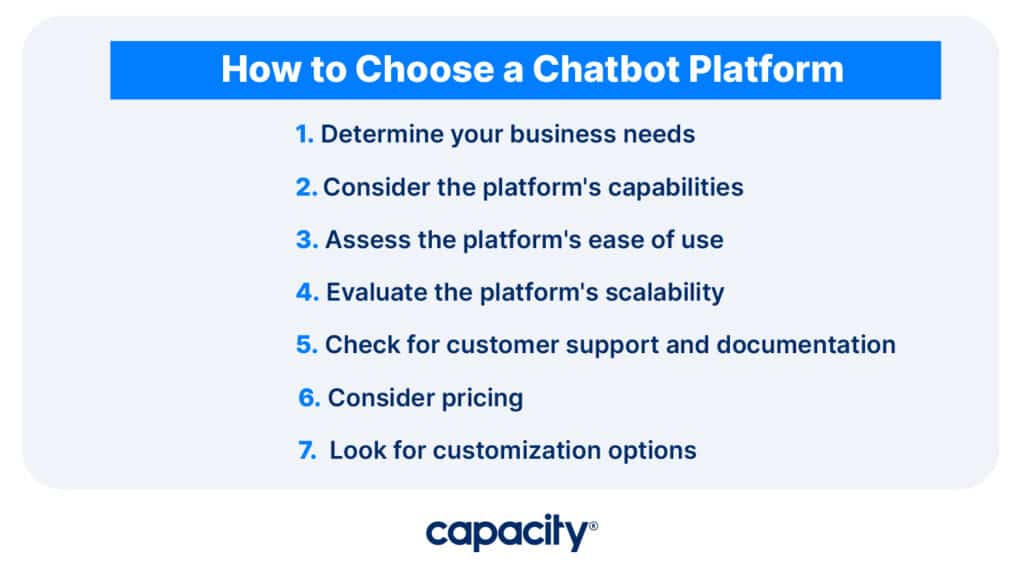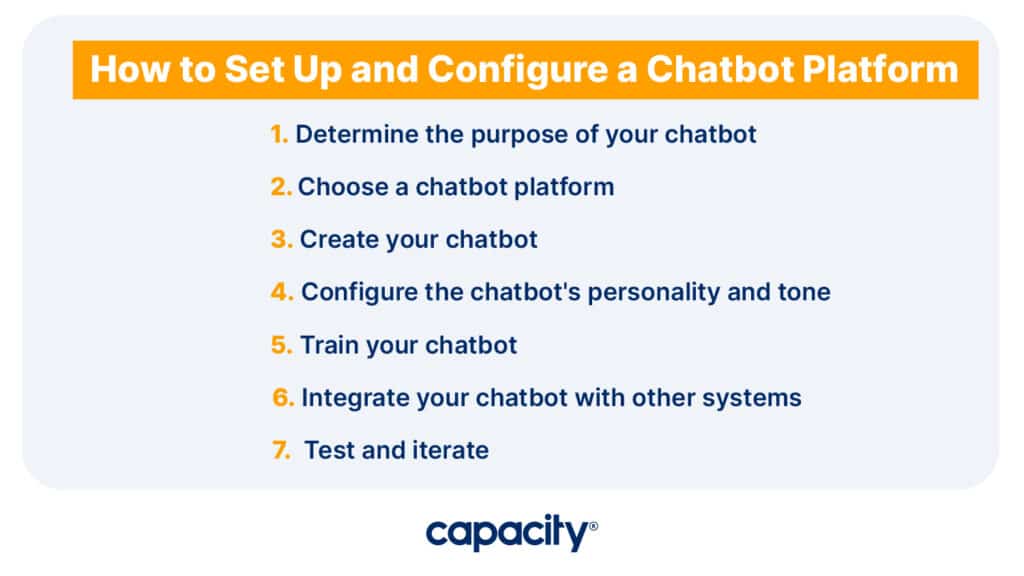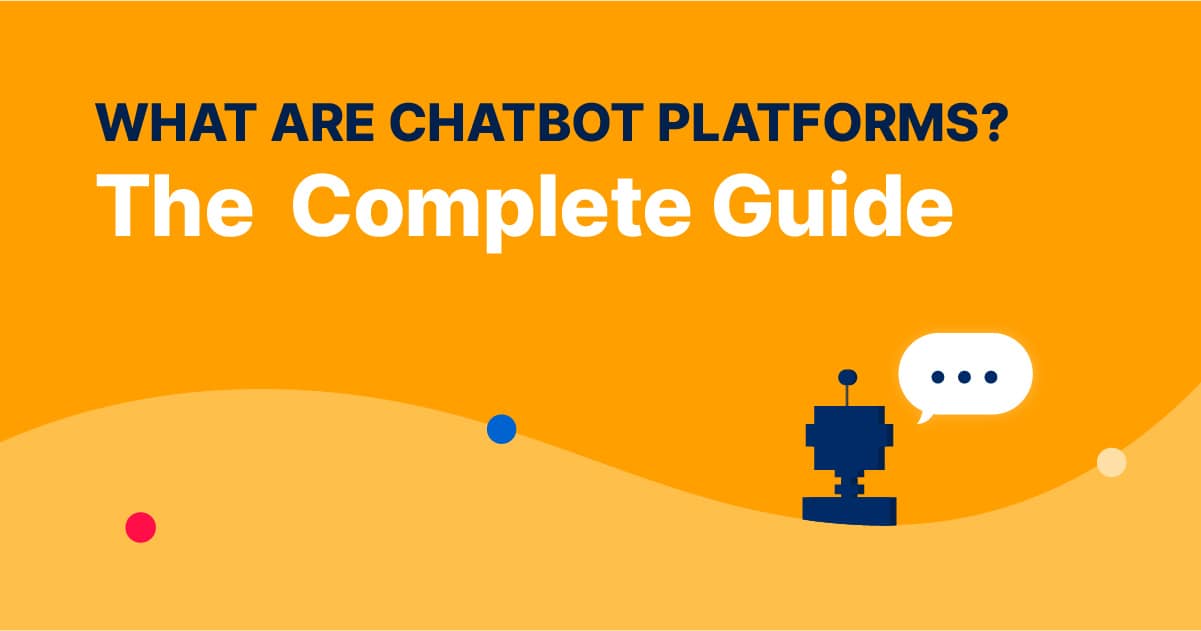Are you wondering if a chatbot platform is right for your business? It’s an important consideration in this modern age as we increasingly turn to automation and AI solutions to help us meet customer needs conveniently and efficiently.
Thankfully, with the latest advancements in technology, powerful chatbot platforms can handle a wide range of conversations, quickly address FAQs and inquiries, and reduce customer wait times— all without straining budgetary resources.
Let’s get started!

Automate Your Work
Capacity’s enterprise AI chatbot can help:
- Answer FAQs anytime, anywhere
- Find relevant documents within seconds
- Give surveys and collect feedback
What is a Chatbot Platform?
A chatbot platform is a software or service that allows individuals or businesses to create, deploy, and manage chatbots for various purposes. Chatbots are computer programs designed to simulate human conversation and interact with users through messaging apps, websites, or voice assistants.

5 Tools and Features Offered by Chatbot Platforms
Chatbot platforms provide a range of tools and features that enable users to build chatbots without writing any code or performing technical tasks. These tools may include:
Drag-and-Drop Interfaces
This feature of a chatbot platform allows users to design and build the conversational flow of their chatbot by dragging and dropping pre-built elements or modules. These modules may include messages, buttons, images, and other interactive features that guide the user through the chatbot conversation.
Natural language processing (NLP) capabilities
NLP is a branch of artificial intelligence that enables chatbots to understand and interpret human language. A chatbot platform with NLP capabilities can recognize user intent, extract relevant information, and respond accurately to user queries.
Integrations with various messaging channels and platforms
Chatbots can be deployed on various messaging channels and platforms, including Facebook Messenger, WhatsApp, Slack, and other proprietary software. Put simply, a chatbot platform that offers integrations with multiple messaging channels and platforms makes it easier for businesses to reach their target audience on their preferred messaging app or platform.
Pre-built templates
Some chatbot platforms may also offer pre-built templates or AI models that can be customized to fit specific use cases, such as customer support, lead generation, or e-commerce. Additionally, chatbot platforms may provide analytics and reporting tools to help businesses track their chatbot performance and user engagement.

Benefits Of AI Chatbot Platforms
Chatbots can provide numerous benefits to companies. Let’s take a look at a few of the top ones:
- Improved Customer Engagement: AI chatbot platforms enable businesses to provide 24/7 customer support and instant responses to customer queries, improving customer engagement and satisfaction.
- Increased Efficiency: AI chatbots can quickly and accurately respond to customer queries, reducing response times and increasing productivity. Chatbots can also handle multiple customer conversations simultaneously, improving efficiency and allowing businesses to take more inquiries.
- Personalized Experience: AI chatbots can be programmed to understand customer preferences and provide personalized recommendations and responses. This customized experience can help businesses build customer loyalty and increase the chances of repeat business.
- Scalability: AI chatbots can handle unlimited customer queries, making it easier for companies to scale their customer support operations. Chatbots can also be trained and updated quickly, making it simple to add new features and improve their performance over time.
- Valuable Insights: AI chatbots can collect data on customer interactions and behaviors, providing businesses with valuable insights that can be used to improve their products and services.

How to Choose a Chatbot Platform?
Here are some key factors to consider when selecting a chatbot platform.
1. Determine your business needs
Before selecting a chatbot platform, you must identify what you want to achieve with the chatbot. Are you looking to improve customer support, generate leads, or automate tasks? This will help you choose a platform that meets your business needs.
2. Consider the platform’s capabilities
Chatbot platforms differ in capabilities, so you must assess each platform’s features and determine whether they align with your business needs.
Some key features to look out for include:
- Natural language processing (NLP)
- Machine learning capabilities
- Analytics dashboards
- Integrations with other essential systems
3. Assess the platform’s ease of use
A chatbot platform should be easy to use, even if you don’t have technical expertise. Look for a platform with a user-friendly interface and straightforward configuration tools that allow you to set up and customize your chatbot quickly.
4. Evaluate the platform’s scalability
As your business grows, you need a chatbot platform to scale with you. Ensure the platform can handle many users and requests without compromising performance.
Chatbot platforms are essential to scaling a business. Using AI, chatbots can quickly respond to customer inquiries and automate repetitive tasks, allowing companies to grow without hiring more staff or increasing operational costs. Additionally, they can collect valuable data on user interactions and behaviors, which can be used to improve products and services.
5. Check for customer support and documentation
Even with a user-friendly platform, you may encounter challenges during the chatbot setup process. Look for a platform with excellent customer support that can assist when needed.
Additionally, ensure that the platform has comprehensive documentation to help you troubleshoot common issues.
6. Consider pricing
The cost of a chatbot platform can vary widely, so it’s essential to consider your budget when choosing a platform. Look for a platform that offers pricing plans that align with your budget and business needs. Capacity has a wide range of pricing options to fit any company’s budget.
7. Look for customization options
While chatbot platforms like Capacity offers pre-built templates and allow you to customize your chatbot with your brand’s colors and logo. Consider the level of customization you require and look for a platform that can provide it.

How to Set Up and Configure a Chatbot Platform
Setting up and configuring a chatbot platform can seem daunting, but it can be done relatively easily with the proper guidance. Here are some general steps to follow when setting up and configuring a chatbot platform:
- Step #1. Determine the purpose of your chatbot – The first step is to determine the purpose of your chatbot. Is it for customer support, lead generation, or something else? This will help you choose the right chatbot platform and configure it accordingly.
- Step #2. Choose a chatbot platform – Once you have determined your chatbot’s purpose, choose one that best fits your needs. Consider factors such as cost, ease of use, features, and integrations.
- Step #3. Create your chatbot – Depending on your chosen platform, you will need to create your chatbot. This may involve setting up a conversational flow, responding to common questions, and configuring integrations with other systems, such as your CRM.
- Step #4. Configure the chatbot’s personality and tone – Your personality and style will play a significant role in how users perceive it. Consider the tone of voice, language, and humor that aligns with your brand voice.
- Step #5. Train your chatbot – Most platforms use machine learning and natural language processing to improve over time. You must train your chatbot by providing data on common questions and answers.
- Step #6. Integrate your chatbot with other systems – If you want it to be more effective, consider integrating it with other systems, such as your CRM, social media platforms, or marketing automation tools.
- Step #7. Test and iterate – Once you have set up and configured your chatbot, it is crucial to test it thoroughly and iterate as needed. Monitor the chatbot’s performance and user feedback, and make adjustments to improve its effectiveness.
You can follow these steps to find the best Chatbot Platforms.
What is the Best Chatbot Platform?
Here is a list of 3 most popular AI chatbot platforms
#1. Capacity – The Best Overall
Capacity is an AI-powered support automation platform that connects your entire tech stack to answer questions, automate repetitive support tasks, and build solutions to any business challenge.
Why Choose Capacity?
Capacity provides everything you need to automate support and business processes in one powerful platform. Capacity’s low-code platform, accessible through conversational AI, enables graceful human handoffs and intuitive task management via a:
- Powerful workflow automation suite
- Robust developer platform
- Flexible database that can be deployed anywhere.

Automate Your Work
Capacity’s enterprise AI chatbot can help:
- Answer FAQs anytime, anywhere
- Find relevant documents within seconds
- Give surveys and collect feedback
Additionally, Capacity’s unified AI-powered platform empowers teams everywhere to:
- Answer over 90% of your FAQs with an all-in-one helpdesk and reduce the tickets in your support team’s queue.
- Automate tedious processes and tasks with low-code workflows to increase productivity in cross‑functional teams.
- Build solutions to empower your employees with access to information via a user-friendly knowledge base, suite of app integrations, and conversational interface.
#2. Alexa for Business
Alexa for Business is a cloud-based voice service from Amazon that helps businesses manage their operations with Alexa. With Alexa for Business, companies can create and use voice experiences tailored to their needs, including training employees on new processes, managing meeting rooms, and integrating with existing systems.
Why Choose Alexa for Business?
Alexa for Business provides a comprehensive suite of capabilities that you can use to build sophisticated chatbot experiences tailored to your business needs. It allows you to:
- Create custom skills using the AWS Lambda service or an integrated development environment (IDE).
- Integrate with enterprise applications like Salesforce and Microsoft Office 365.
- Develop voice applications that use AI-based technologies like automatic speech recognition (ASR) and natural language understanding (NLU).
#3. IBM Watson
IBM Watson is an AI-powered platform that enables developers to quickly and easily create conversational chatbot experiences. It’s designed to help businesses rapidly develop, deploy, and manage AI-powered applications and services across any platform or device.
Why Choose IBM Watson?
IBM Watson is a powerful tool for creating personalized chatbot experiences that can be deployed on any platform. With IBM Watson, you can:
- Use advanced machine learning algorithms to generate intelligent responses in natural language.
- Create custom data models that enable your chatbot to understand customer requests better.
- Integrate with popular messaging platforms such as Facebook Messenger, Twitter DM, and Slack.
Want To Try AI Chatbot Technology For Free?
Ultimately, Capacity is the best chatbot platform for businesses looking to automate support and business processes. With its powerful workflow automation suite, robust developer platform, and flexible database that can be deployed anywhere, Capacity provides everything you need to create AI-powered experiences tailored to your company’s needs.
Don’t wait any longer – get started with Capacity!





